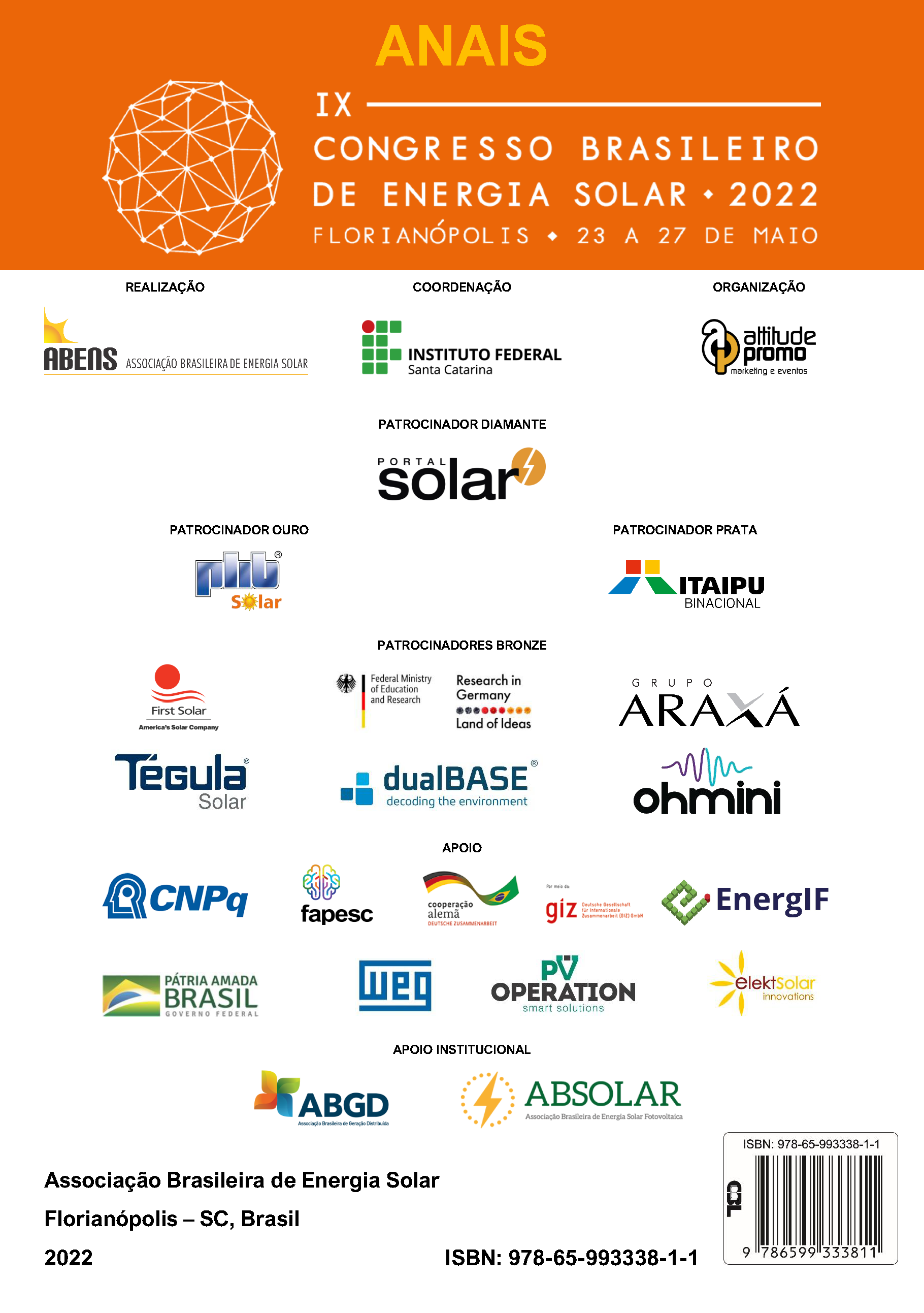MESOSCALE SIMULATION OF OFFSHORE-TYPE WINDS USING LIDAR OBSERVATIONS AT A COASTAL WIND FARM IN NORTHEAST BRAZIL
DOI:
https://doi.org/10.59627/cbens.2022.1204Keywords:
Offshore Wind, LiDAR, WRFAbstract
Weather forecasting and simulation in coastal regions presents research challenges coming from the limitation of atmospheric forecast models in representing this type of terrain. The role of wind power in the energy transition unfolds in collective efforts to research the behavior of winds in coastal regions from the integration between spatio-temporal models and data measured by remote sensing techniques using LiDAR profilers. The objective of this study is to evaluate the performance of the WRF mesoscale model in the representation of coastal winds with offshore characteristics using four different boundary layer configurations and different resolutions for the vertical levels. The studied region includes the Pedra do Sal Wind Power Plant located in the coastal region of Parnaíba-PI and presents a predominance of offshore winds that arise from the combination of the trade winds with the local sea breeze. The simulations were validated with measurements carried out in the park by LiDAR and anemometric tower. The results reveal a good performance of the model regarding wind direction and temperature. More specifically, although the simulations show a lag of about 2 hours to represent the daily wind cycle, the average wind speed was well represented. For vertical shear, the models are similar for altitudes above 300 m and below 200 m.
Downloads
References
ABEEOLICA. http://abeeolica.org.br/ Acesso: 10/12/2021.
BARTHELMIE, R. J.; BADGER, J.; PRYOR, S. C.; HASAGER, C. B.; CHRISTIANSEN, M. B.; JØRGENSEN, B. H. Offshore coastal wind speed gradients: Issues for the design and development of large offshore windfarms. Wind Engineering, v. 31, n. 6, p. 369-382, 2007.
CARVALHO, D. J. S. Optimização do modelo numérico de previsão do tempo WRF no contexto de previsão e produção de energia eólica. Dissertation (Master in Meteorology and Physical Oceanography) - Universidade de Aveiro, Portugal, 2009.
COIMBRA, I.L.. Investigation of a coastal wind farm at northeast brazil using the wrf model. Dissertação de mestrado. Universidade federal de santa catarina. Florianópolis, 2018.
DEBNATH. M.; DOUBRAWA. P.; OPTIS. M.; HAWBECKER. P.; BODINI. N. 2021. Extreme wind shear events in US offshore wind energy areas and the role of induced stratification. Wind Energy Science. DOI:10.5194/wes-6-1043-2021.
EPE. Balanço Energético Nacional - ano base 2017. EPE/Empresa de Pesquisa Energética, Brasil, 2018a.
FUERTES, F.C.; IUNGO, G.V.; Porte-Agel, F. 3D turbulence measurements using three synchronous wind lidars: Validation against sonic anemometry. J. Atmos. Ocean. Technol. 2014, 31, 1549–1556.
GOIT. J.; YAMAGUCHI. A.;ISHIHARA. T. 2020. Measurement and Prediction of Wind Fields at na Offshore Site by Scanning Doppler LiDAR and WRF. DOI:10.3390/atmos11050442.
HERSBACH, Hans et al. 2020. The ERA5 global reanalysis. Quarterly Journal of the Royal Meteorological Society, v. 146, n. 730, p. 1999–2049. ISSN 1477870X. DOI: 10.1002/qj.3803.
MANN, J.; CARIOU, J.P.; COURTNEY, M.S.; PARMENTIER, R.; MIKKELSEN, T.; WAGNER, R.; LINDELÖW, P.; SJÖHOLM, M.; ENEVOLDSEN, K. 2009. Comparison of 3D turbulence measurements using three staring wind lidars and a sonic anemometer. DOI:10.1088/1755-1315/1/1/012012.
MILLER, S. T. K. et al. Sea breeze: Structure, forecasting, and impacts. Reviews of Geophysics, v. 41, n. 3, 2003.
NAKANISHI, Mikio; NIINO, Hiroshi. An Improved Mellor–Yamada Level-3 Model: Its Numerical Stability and Application to a Regional Prediction of Advection Fog. Boundary-Layer Meteorology, Elsevier Ltd, v. 119, p. 397–407, 2006. DOI: https://doi.org/10.1007/s10546-005-9030-8.
OPTIS. M.; BODINI. N.; DEBNATH. M.; DOUBRAWA. P. 2021. New methods to improve the vertical extrapolation of near-surface offshore wind speeds. Wind Energy Science. National Renewable Energy Laboratory, Golden. DOI:10.5194/wes-2021-5.
PETTAS, V.; KRETSCHMER, M.; CLIFTON, A.; CHENG, P. 2021. On the effects of inter-farm interactions at the offshore wind farm Alpha Ventus. Wind Energy Science. DOI:10.5194/wes-2021-50.
PORTÉ-AGEL, FERNANDO; BASTANKHAH, MAJID; SHAMSODDIN, SINA. Wind-Turbine and Wind-Farm Flows: A Review. Boundary-Layer Meteorology, Springer Netherlands, v. 174, n.1, p.1-59, Jan. 2020. ISSN 0006-8314. DOI: 10.1007/s10546-019-00473-0.
SAKAGAMI, Y. 2017. Influência da turbulência e do perfil de velocidade do vento no desempenho de aerogeradores em dois parques eólicos na costa do nordeste brasileiro. Tese de Doutorado, POSMEC, UFSC, Florianópolis.
SAKAGAMI, Y.; SANTOS, P. A. HAAS, R.; PASSOS J. C.; TAVES, F.F. 2015. Effects of turbulence wind shear wind veer and atmospheric stability on power performance: a case study in Brazil. Proceeding EWEA Conference.
SANTOS ATS, SANTOS E SILVA CM, LEMOS DF, OLIVEIRA LL, BEZERRA LAC. 2016. Assessment of wind resources in two parts of Northeast Brazil with the use of numerical models. Meteorological Applications. DOI:10.1002/met.1595.
SKAMAROCK, W. C.; CO-AUTHORS. Description of the Advanced Research WRF Version 3 (No. NCAR/TN-475+STR). [S.l.], 2008. p. 26. DOI: http://dx.doi.org/10.5065/D68S4MVH.
SONG-YOU HONG, Yign Noh; DUDHIA, Jimy. A new vertical diffusion package withan explicit treatment of entrainment processes. Monthly Weather Review, v. 134, n. 9, p. 2318–2341, 2006. DOI: https://doi.org/10.1175/MWR3199.1.
SURUSSAVADEE, C. Evaluation of WRF near-surface wind simulations in Tropics employing different planetary boundary layer schemes. The 8th International Renewable Energy congress, 2017. DOI:10.1109/IREC.2017.7926005
SVENSSON. N.; ARNQVIST. J.; BERGSTRÖM. H.; RUTGERSSON. A.; SAHLÉE. E. 2019. Measurements and Modelling of Offshore Wind Profiles in a Semi-Enclosed Sea. Atmosphere. DOI:10.3390/atmos10040194.
VEERS, PAUL ET AL. Grand challenges in the science of wind energy. Science, v. 366, n. 6464, eaau2027, Oct. 2019. ISSN 0036-8075. DOI: 10.1126/science.aau2027.
SAKAGAMI, P.A.A. SANTOS, R. HAAS, J.C. PASSOS, AND F.F. TAVES. 2013 “Wind shear assessment using wind LiDAR profiler and sonic 3D for wind energy applications - Preliminary Results,” Proceedings of World Renewable Energy Congress XIII, London.


